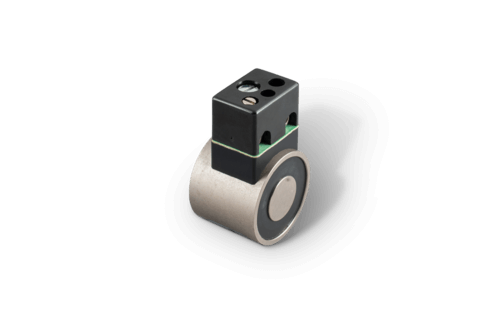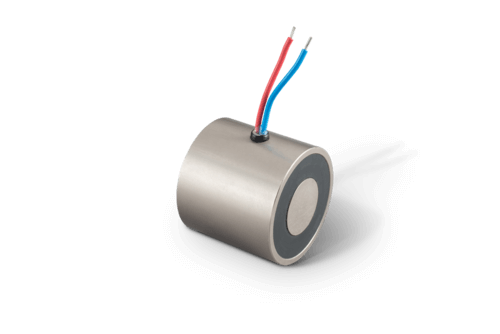Holding Magnets
You want to fix or transport even magnetic work pieces in a simple way? Doors or flaps need to be kept open or closed? You need a very short stroke but high holding forces?
Our holding magnets are your solution.
We offer holding solenoids and permanent holding magnets with bare or galvanised pole surface and appropriate counterparts, called armatures.
FAQ Shotbolt Locking Units
When are holding magnets used?
Holding magnets are used when only little strokes are needed or in case workpieces and/or the optional armature are to be retained.
Which holding forces can be realized with holding magnets?
Our standard programme contains holding magnets within a diameter range of 20 to 100 mm. Their sizes depend on the holding power between 80 and 3700 Newton.
Here, the holding power as indicated in the data sheet only materializes when the workpiece is in line with the suggested armature as far as dimensions and material is concerned and when there is no air gap between workpiece and the holding magnet‘s pole face by lags, unevenness, staining or corrosion. Even minimal air spaces reduce the holding power considerably.
What is the difference between a holding magnet and a permanent holding magnet?
The two devices differ in their functionality, considering the dimensions, the permanent holding magnet is higher. Basically, the holding magnet consists of a coil which sticks in a magnetically soft jar. If the coil is energized, a magnetic field is created on the pole surface, ferromagnetic parts are adducted.
The permanent holding magnet contains, in addition to the coil, a permanent magnet which provides for permanent adduction of ferromagnetic parts. By polarity-correct energizing of the coil, the magnetic field of the permanent magnet’s magnetic field is weakened – the holding force decreases to a low residual holding force.
How to fasten holding magnets
For mounting reasons, our holding magnets have one or more tapped bores on their backside. For customer specific solutions, other fastenings such as clamping on periphery, flange mounting or fastening via a turned collar or groove are possible.
Why does the holding magnet’s magnetic force decrease faster than that of a single acting solenoid?
The air gap, i.e. the distance between armature and pole surface, is a substantial resistance for the magnetic field. The holding magnet’s comparably simple functionality principle accounts for two effective air gaps to be created between pole surface and armature. With regard to single acting solenoids, the number of effective air gaps is reduced by suitable construction measures. This allows for higher forces to be realized over larger strokes.
On the pole surface, a black ring can be seen. What's behind it?
The black ring consists of special sealing compounds with which the coil is fixed in the magnetic jar. In order to make sure that the sealing compound does not exceed the pole surface, thus creating an undesired air gap, it is slightly offset from the pole surface.






























 +49 8331 1040
+49 8331 1040 info@magnet-schultz.com
info@magnet-schultz.com